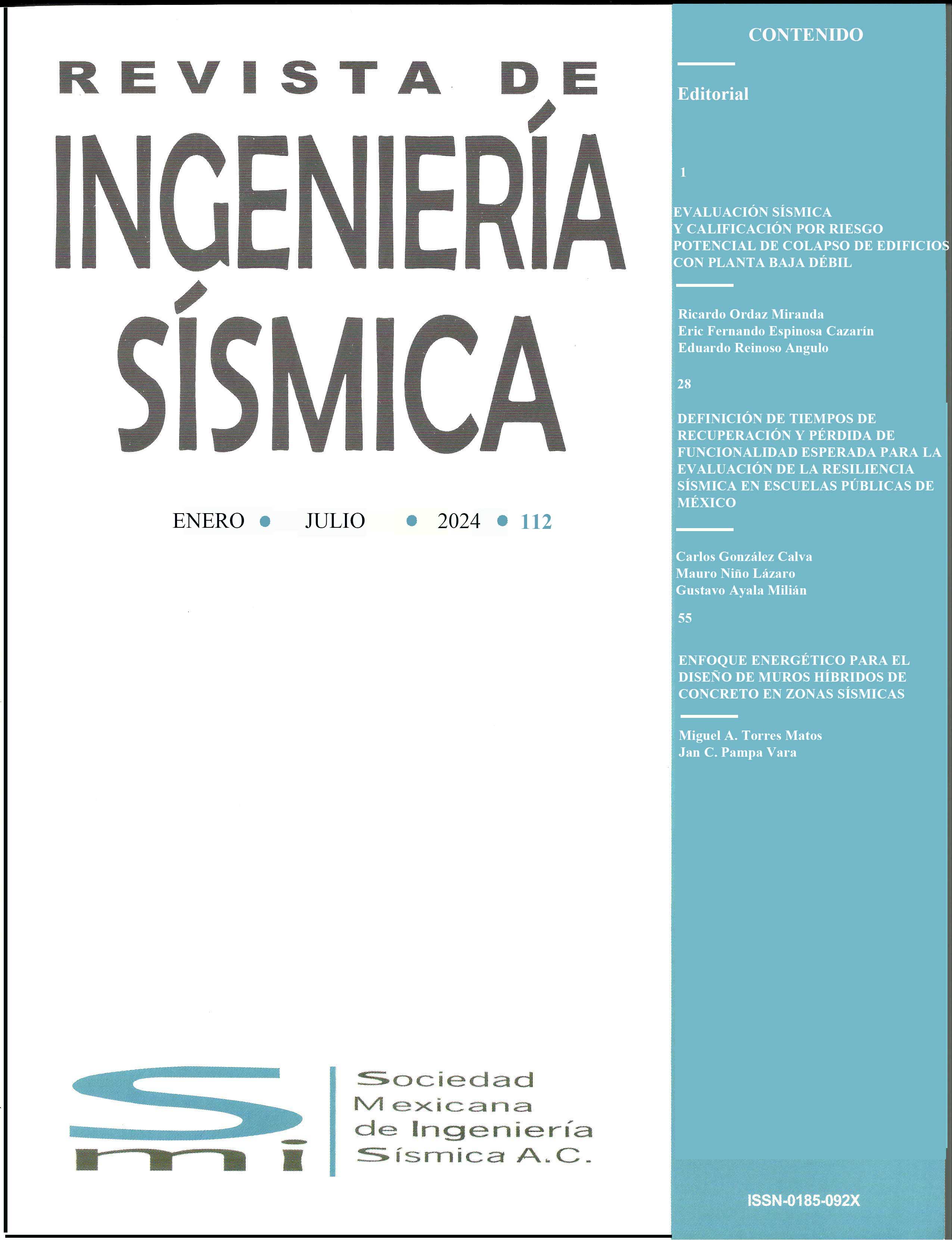SEISMIC EVALUATION AND CLASSIFICATION BY POTENTIAL RISK OF COLLAPSE OF BUILDINGS WITH PBD
DOI:
https://doi.org/10.18867/ris.112.656Keywords:
structural pathology, soft story, probaility of collapse, failure mechanism, concrete framesAbstract
This article proposes to evaluate and classify the intensity of the pathology of soft story (SS). The SS classification will serve so that, within the universe of buildings that present this pathology, decisions may be made about which buildings require priority attention to avoid serious damage when the next major seismic event occurs. For the analysis, three models were developed based on the geometric characteristics of the most representative cases of buildings with SS damaged by the earthquake of September 19, 2017. The existence of the SS is evaluated using the Complementary Technical Standards for Earthquake Design (2020) and the models are classified by applying two methods: 1) the FEMA P-2018 method; and 2) a proposal for adapting the FEMA P-2018 with the guidelines established in the Complementary Technical Standards of Mexico City (NTC -2020). The results obtained were consistent in each of the cases analyzed, concluding that the application of this methodology allows the identification of the structures with PBD that are most susceptible to collapse; therefore, that require priority attention over others.
Downloads
References
ACI-318-14, (2014), Building code requirements for structural concrete and commentary (ACI 318-14), American Concrete Institute, Farmington Hills, Michigan, USA, 524 pp.
ASCE (2016), Minimum Design Loads and Associated Criteria for Buildings and Other Structures, ASCE 7-16, American Society of Civil Engineers, Vol. 2, 889 pp.
ASCE (2017). Seismic Evaluation and Retrofit of Existing Buildings. In Seismic Evaluation and Retrofit of Existing Building, ASCE/SEI 41-17, American Society of Civil Engineers, 623 pp.
Amirsardari, A, P Rajeev, H M Goldsworthy y E Lumantarna (2016), “Modelling non-ductile reinforced concrete columns”. Australian Earthquake Engineering Society Conference.
Buendía, L M, y E Reinoso (2019). “Análisis de los daños en viviendas y edificios comerciales durante la ocurrencia del sismo del 19 de septiembre de 2017”. Revista de Ingeniería Sismica, SMIS. No 101, pp. 19-35. DOI: 10.18867/ris.101.508
Elwood, K.J. and Moehle, J.P. (2003) “Shake Table Tests and Analytical Studies on the Gravity Load Collapse of Reinforced concrete Frames”, PEER report 2003/01, Berkeley: Pacific Earthquake Engineering Research Center, University of California.
FEMA (2018). Seismic Evaluation of Older Concrete Buildings for Collapse Potential, FEMA P-2018, Federal Emergency Management Agency, Washington, D.C, 352 pp.
Gobierno del Distrito Federal (1976), “Reglamento de Construcciones del Distrito Federal”, Diario Oficial de la Federación, Distrito Federal, México
Gobierno del Distrito Federal (2020), “Normas Técnicas Complementarias para Diseño y Construcción de Estructuras de Concreto”, Diario Oficial de la Federación, Distrito Federal, México
Gobierno del Distrito Federal. (2020), “Normas Técnicas Complementarias para el Diseño por Sismo”, Diario Oficial de la Federación, Ciudad de México, México
Gobierno del Distrito Federal. (2020). Reglamento de Construcciones del Distrito Federal. En Gaceta Oficial de la Ciudad de México.
Instituto de Ingeniería UNAM (1977). “Normas Técnicas Complementarias del Reglamento de Construcciones para el Distrito Federal”, Diseño y construcción de estructuras de concreto con comentarios, ayudas de diseño y ejemplos, UNAM, 302 pp
Meli, R., y Hernández, Ó. (1970). Propiedades de piezas para mampostería producidas en el Distrito Federal. Facultad de Ingeniería, UNAM.
New Zealand Standard (NZS 3101.1:1982). (1982). Code of practice for the design of concrete structures.
Ordaz-Miranda, R (2023), “Evaluación y clasificación por colapso potencial de edificios con planta baja débil en la Ciudad de México”, Tesis de Maestría, Programa de Maestría y Doctorado en Ingeniería, UNAM, México.
Stirrat, A T, A S Gebreyohaness, R D Jury y W Y Kam (2014), “Seismic performance assessment of non-ductile columns, 2014 NZSEE Conference, Beca Ltd, New Zealand, 17 pp.

Downloads
Published
Versions
- 2024-07-19 (2)
- 2024-06-28 (1)
How to Cite
Issue
Section
License
Copyright (c) 2024 Journal of Earthquake Engineering

This work is licensed under a Creative Commons Attribution-NonCommercial 4.0 International License.





